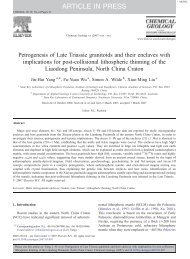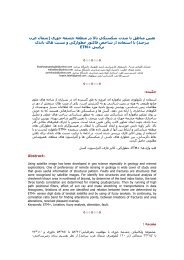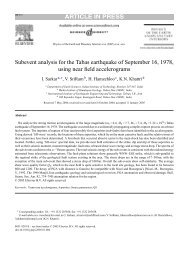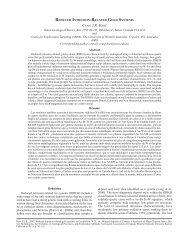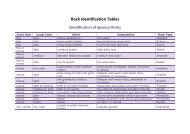Patterns of Historical Earthquake Rupture in the Iranian Plateau
Patterns of Historical Earthquake Rupture in the Iranian Plateau
Patterns of Historical Earthquake Rupture in the Iranian Plateau
- No tags were found...
You also want an ePaper? Increase the reach of your titles
YUMPU automatically turns print PDFs into web optimized ePapers that Google loves.
<strong>Patterns</strong> <strong>of</strong> <strong>Historical</strong> <strong>Earthquake</strong> <strong>Rupture</strong> <strong>in</strong> <strong>the</strong> <strong>Iranian</strong> <strong>Plateau</strong> 137O<strong>the</strong>r historical earthquakes have not occurred <strong>in</strong> sequences.These <strong>in</strong>clude earthquakes on <strong>the</strong> Sabzevar reversefault <strong>in</strong> 1052, <strong>the</strong> Esfarayen reverse fault <strong>in</strong> 1695, and anevent on <strong>the</strong> Damghan fault <strong>in</strong> 856. The Ipak reverse faultruptured <strong>in</strong> 1962 with an earthquake <strong>of</strong> M 7.2. The penultimatehistorical event probably occurred <strong>in</strong> <strong>the</strong> third millenniumB.C.The long historical record suggests that <strong>the</strong> areas <strong>of</strong> historicalearthquakes are not likely to susta<strong>in</strong> earthquakes <strong>of</strong>M -- 8 where earthquakes rupture segments <strong>in</strong>dividuallyra<strong>the</strong>r than several segments at once. None<strong>the</strong>less, severallong, straight strike-slip faults (Doruneh, Nayband, WestNeh, East Neh, Kahurak) have not susta<strong>in</strong>ed historical earthquakesand, by analogy with large earthquakes <strong>in</strong> Mongolia<strong>in</strong> <strong>the</strong> twentieth century, may be capable <strong>of</strong> earthquakes <strong>of</strong>M8.The seismic moment release rate <strong>in</strong> I_ran accounts foronly a small part <strong>of</strong> <strong>the</strong> convergence rate between <strong>the</strong> Arabianand Eurasian plates. The deficit may be due to aseismicslip, or it may be because <strong>the</strong> <strong>Iranian</strong> historical record, longas it is, is not sufficient to sample long-term deformationacross <strong>the</strong> plateau. To resolve this question for purposes <strong>of</strong>seismic hazard assessment, a national program should beestablished to (1) determ<strong>in</strong>e <strong>the</strong> paleoseismological history<strong>of</strong> faults that have produced earthquakes, as well as longstrike-slip faults that have not, and (2) establish a GPS network,<strong>in</strong>clud<strong>in</strong>g permanent stations around major metropolitanareas, to monitor <strong>the</strong> present-day stra<strong>in</strong> accumulationacross <strong>the</strong> <strong>Iranian</strong> plateau.AcknowledgmentsThis article was first presented <strong>in</strong> September 1994, at <strong>the</strong> Marshall, California,workshop on paleoseismology sponsored by <strong>the</strong> Inter-Union Commissionon <strong>the</strong> Lithosphere (ICL) and <strong>the</strong> U.S. Geological Survey, withadditional support from <strong>the</strong> U.S. Nuclear Regulatory Commission. M.B.thanks UNESCO, Paris, especially Badauoi Rouhban, and <strong>the</strong> InternationalInstitute <strong>of</strong> <strong>Earthquake</strong> Eng<strong>in</strong>eer<strong>in</strong>g and Seismology (IIEES), especiallyMohsen Ghafuri-Ashtiani, Tehran, for support for his work published asBerberian (1995b), as well as Manuchehr Qorashi and o<strong>the</strong>r colleagues<strong>the</strong> Geological Survey <strong>of</strong> Iran for valuable discussions. Many <strong>of</strong> <strong>the</strong> field<strong>in</strong>vestigations were carried out while M.B. was work<strong>in</strong>g for <strong>the</strong> GeologicalSurvey <strong>of</strong> Iran. M.B. acknowledges travel support from ICL, GeologicalSurvey <strong>of</strong> Iran, and IIEES to <strong>in</strong>vestigate surface rupture on <strong>the</strong> Abiz faultas a result <strong>of</strong> <strong>the</strong> 1997 earthquake <strong>of</strong> Ms 7.3. R.S.Y. received support fromNational <strong>Earthquake</strong> Hazards Reduction Program Grant 1434-94-G-SC5090 from <strong>the</strong> U.S. Geological Survey. We thank James A. Jackson <strong>of</strong>Cambridge University and Muawia Barazangi <strong>of</strong> Cornell University for<strong>the</strong>ir helpful comments on <strong>the</strong> orig<strong>in</strong>al version <strong>of</strong> <strong>the</strong> manuscript; LisaGrant, Doug Yule, and Aykut Barka for <strong>the</strong> present version; and Christ<strong>in</strong>eJohnson, Wayne Siu, and Enny Am<strong>in</strong>ian for draft<strong>in</strong>g <strong>the</strong> figures. This articleis a contribution from Task Group II-3 <strong>of</strong> <strong>the</strong> Inter-Union Commission on<strong>the</strong> Lithosphere.ReferencesAmbraseys, N. N. (1970). Some characteristic features <strong>of</strong> <strong>the</strong> Anatolianfault zone, Tectonophysics 9, 143-165.Ambraseys, N. N. and C. P. Melville (1977). The seismicity <strong>of</strong> Kuhistan,Iran, Geograph. J. 143, 179-199.Ambraseys, N. N. and C. P. Melville (1982). A History <strong>of</strong> Persian <strong>Earthquake</strong>s,Cambridge University Press, London, 219 pp.Ambraseys, N. N. and J. S. Tchalenko (1969). Dasht-e-Bayaz earthquake<strong>of</strong> 31 August 1968, UNESCO Publ. Serial No. 1214/BMS.RD/SCE,Paris, 1-15.Arakel Vartabed Tavrizetsi (1670). History <strong>of</strong> Armenia, 1574 to 1665 AD,orig<strong>in</strong>al <strong>in</strong> Armenian, Repr<strong>in</strong>ted by Vagharshapat Terza Edizione(1896); Translated <strong>in</strong>to French by Brosset, Collection d’HistoirensArmeniens I, St. Petersburg, 2 vols. (1874), 496-497.Arpat, E., F. Faroglu, and H. B. Iz (1977). The 1976 Calderan earthquake,Yeryuvari Insan 2, 29-41 (<strong>in</strong> Turkish).Balj<strong>in</strong>nyam, I., A. Bayasgalan, B.Z. Borisov, A. Cisternas, M.G.Dem’yarovich, I. Ganbaatar, V. M. Kochetkov, R. A. Kurush<strong>in</strong>, P.Molnar, H. Philip, and Y. Y. Vashchilov (1993). <strong>Rupture</strong>s <strong>of</strong> majorearthquakes and active deformation <strong>in</strong> Mongolia, Geol. Soc. Am.Mem. 181, 66 pp.Bar-Hebraeus (1286). Chronography: Translation <strong>of</strong> <strong>the</strong> Short History<strong>the</strong> States (Tarjorne-ye-Tarikh-e-Mokhtasar al-Doval), Translated<strong>in</strong>to Persian by Mohammad ’Ali Tajvar and Heshmatolah Riyazi,Etala’at Publ., Tehran, 1985 (<strong>in</strong> Persian).Barka, A. (1992). The North Anatolian fault zone, Annales Tectonicae,Special Issue, Supp., 6, 164-195.Bayarsayhan, C., A. Bayasgalan, B. Enkhtuvsh<strong>in</strong>, K. W. Hudnut, R. A.Kurnsh<strong>in</strong>, P. Molnar, and M. Olziybat (1996). The 1957 Gobi-Altay,Mongolia, earthquake as a prototype for sou<strong>the</strong>rn California’s mostdevastat<strong>in</strong>g earthquake, Geology 24, 579-582.Bennett, R. A., R. E. Reil<strong>in</strong>ger, W. R. Y<strong>in</strong>gp<strong>in</strong>g Li, and M. N. Toksoz(1995). Coseismic fault slip associated with <strong>the</strong> 1992 Mw 6.1 JoshuaTree, California, earthquake: implications for <strong>the</strong> Joshua Tree-Landersearthquake sequence, J. Geophys. Res. 100, 6443-6461.Berberian, M. (1979). <strong>Earthquake</strong> fault<strong>in</strong>g and bedd<strong>in</strong>g thrust associatedwith <strong>the</strong> Tabas-e-Golshan (Iran) earthquake <strong>of</strong> September 16, 1978,Bull. Seism. Soc. Am. 69, 1861-1887.Berberian, M. (1981). Active fault<strong>in</strong>g and tectonics <strong>of</strong> Iran, <strong>in</strong> H. K. Guptaand F. M. Delany (Editors), Zagros-H<strong>in</strong>du Kush-Himalaya GeodynamicEvolution, Am. Geophys. Union, Geodyn. Series 3, 33-69.Berberian, M. (1982). Aftershock tectonics <strong>of</strong> <strong>the</strong> 1978 Tabas-e-Golshan(Iran) earthquake sequence: a documented active ’th<strong>in</strong>- and thicksk<strong>in</strong>nedtectonic’ case, Geophys. J. R. Astr. Soc. 68, 499-530.Berberian, M. (1983a). Generalized tectonic map <strong>of</strong> Iran, <strong>in</strong> M. Berberian(Editor), Cont<strong>in</strong>ental Deformation <strong>in</strong> <strong>the</strong> <strong>Iranian</strong> <strong>Plateau</strong>, Contributionto Seismotectonics <strong>of</strong> Iran, part IV, Geol. Surv. Iran 52, 625 pp.Berberian, M. (1983b). The Sou<strong>the</strong>rn Caspian: a compressional depressionfloored by a trapped, modified oceanic crust, Canadian J. Earth Sci.20, 163-183.Berberian, M. (1995a). Master "bl<strong>in</strong>d" thrust faults hidden under <strong>the</strong> Zagrosfolds: active basement tectonics and surface morphotectonics, Tectonophysics241, 193-224.Berberian, M. (1995b). Natural Hazards and <strong>the</strong> First <strong>Earthquake</strong> Catalogue<strong>of</strong> Iran, vol. 1, <strong>Historical</strong> Hazards <strong>in</strong> Iran Prior to 1900, A UNESCO/IIEES Publication dur<strong>in</strong>g UN/IDNDR: International Institute <strong>of</strong> <strong>Earthquake</strong>Eng<strong>in</strong>eer<strong>in</strong>g and Seismology, Tehran, 603 + 66 pp.Berberian, M. (1997). Seismic sources <strong>of</strong> <strong>the</strong> Transcaucasian historicalearthquakes, <strong>Historical</strong> and Prehistorical <strong>Earthquake</strong>s <strong>in</strong> <strong>the</strong> Caucasus,D. Giard<strong>in</strong>i and S. Balassanian (Editors), NATO Asi Series,Environment, vol. 28, Kluwer Academic Press, The Ne<strong>the</strong>rlands,233-311.Berberian, M. and S. Arshadi (1976). On <strong>the</strong> evidence <strong>of</strong> <strong>the</strong> youngestactivity <strong>of</strong> <strong>the</strong> North Tabriz fault and <strong>the</strong> seismicity <strong>of</strong> Tabriz city,Geol. Surv. Iran 39, 397-418.Berberian, M. and G. C. P. K<strong>in</strong>g (1981). Toward a paleogeography andtectonic evolution <strong>of</strong> Iran, Canadian J. Earth Sci. 18, 210-265.Berberian, M. and M. Qorashi (1987). Seismotectonics and earthquakefaulthazard study <strong>of</strong> <strong>the</strong> Lake Urumiyeh region, Geol. Surv. Iran,and M<strong>in</strong>istry <strong>of</strong> Roads and Transportation, Lake Urumiyeh HighwayProject, 123 pp. (<strong>in</strong> Persian).



